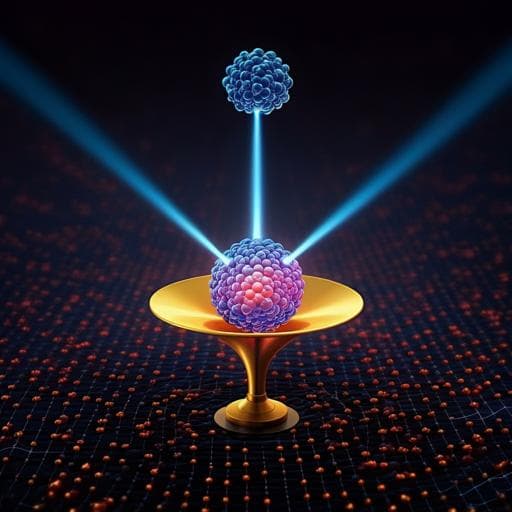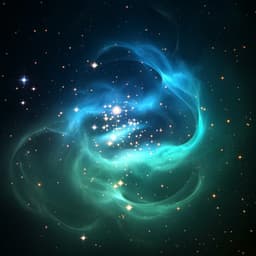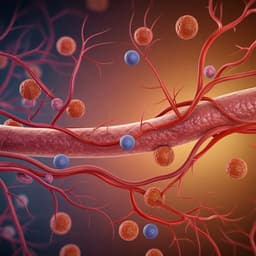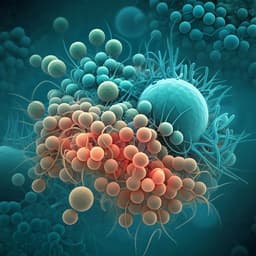
Physics
Hybrid plasmonic nano-emitters with controlled single quantum emitter positioning on the local excitation field
D. Ge, S. Marguet, et al.
Discover the groundbreaking research conducted by Dandan Ge and colleagues on hybrid plasmonic nano-emitters that synergize quantum dots and plasmonic nanoantennas, enabling precise control over light. This study showcases innovative techniques that manipulate active medium positioning, revealing polarization-sensitive emission states and single-photon switching phenomena.
~3 min • Beginner • English
Introduction
The study addresses a key challenge in hybrid plasmonic nanosources: controlling the nanoscale spatial distribution of quantum emitters relative to the polarization-dependent plasmonic near-field and local density of optical states (LDOS) of metal nanostructures. In weak coupling regimes, metal nanostructures modify emitter deexcitation rates (Purcell effect), enabling controlled emission. The emission rate is expressed as γ_em(ν_em) = γ_exc(x,y,z,ν_exc) × Q(ν_em) × ρ(x,y,z)dV, highlighting the roles of excitation rate, quantum yield, and emitter spatial distribution. While incident polarization can tailor γ_exc via near-field control, ρ(x,y,z) is typically uncontrolled when emitters are deposited by spin coating, leading to isotropic distributions and trial-and-error device fabrication. The purpose is to control ρ(x,y,z) to exploit polarization as a fast, remote control over emission, by fabricating anisotropic hybrid emitters whose emitter distributions overlap with polarization-tailored near-fields. The work proposes and demonstrates plasmon-triggered two-photon polymerization to position QD-containing polymer with nanoscale precision around Au nanostructures, enabling polarization-sensitive emission, quantification via an overlap integral metric, and operation down to the single-photon regime.
Literature Review
Prior work has established hybrid plasmonic nanosources combining metal nanoparticles with quantum dots or dyes to enhance and control light emission through Purcell effects and near-field coupling (e.g., enhancements, quenching regimes, bowtie antennas, patch antennas, and spasers). Typical emitter placement methods include spin coating (isotropic, uncontrolled positioning), and more deterministic but complex approaches such as optical/e-beam lithography around emitters, AFM manipulation, and DNA-based assembly to tether emitters in gaps. These methods often lack flexibility for arbitrary positioning and symmetry control, typically restricting emitters to predefined gaps. Earlier plasmon-assisted photopolymerization demonstrated near-field-driven one-photon polymerization on single nanocubes and two-photon polymerization in gaps of nanocube dimers or SU-8 systems, but not controlled two-photon polymerization on single cubes embedding QDs with tunable anisotropy. This work builds on and extends these approaches by using the intrinsic plasmonic near-field to induce two-photon polymerization of a QD-grafted monomer, enabling controlled emitter distributions with designed symmetries and polarization response.
Methodology
- Plasmonic substrates: Single-crystal Au nanocubes (edge 127 ± 2 nm) synthesized via CTAB-mediated seed growth; deposited sparsely (~0.1 µm−2) on ITO-coated glass. Additional Au nanodisks (90 nm diameter, 50 nm thick) fabricated by e-beam lithography were used for comparison.
- Materials: Photosensitive formulation comprising 99 wt% pentaerythritol triacrylate (PETA) grafted with red-emitting CdSe/CdS/ZnS QDs (PL peak ~625 nm; QD diameter 6.6 ± 0.7 nm) and 1 wt% Irgacure 819 (IRG819) photoinitiator supporting two-photon absorption at 780 nm. A diluted formulation (20% of original QD concentration: 0.2 mg QDs per g polymer) was prepared to realize single-/few-QD trapping.
- Plasmon-triggered two-photon polymerization: A Ti:sapphire femtosecond laser at 780 nm (focused with NA 0.6 to ~1.6 µm spot) illuminated single, pre-identified nanoparticles through the substrate. The exposure dose Din = p·Dth with p < 1 (e.g., p = 0.5) was used to prevent far-field polymerization while enabling near-field-induced polymerization localized at plasmonic hotspots. Exposure time was 125 ms; average power 40–400 µW (0.5–5.0 kW cm−2). After exposure, the sample was rinsed (acetone, HCl solution, isopropanol) to remove unpolymerized resin and excess QDs.
- Near-field patterning control: Incident linear polarization set either along the cube diagonal (exciting E symmetry in-plane dipolar mode) or along a cube edge (exciting a symmetric combination of degenerate modes), and circular polarization for nanodisks, to mold polymer lobes mirroring near-field distributions. The polymerized volume contains QDs, defining the emitter spatial distribution ρ(x,y,z).
- Characterization: SEM and AFM identified morphology and polymer distributions; dark-field scattering spectroscopy characterized plasmon resonances (nanocube in-plane dipolar mode near 680 nm in air, shifting in polymer). Differential AFM assessed out-of-plane polymer extension. FDTD simulations (Lumerical, 1 nm grid) calculated near-field distributions at 780 nm (polymerization) and at 405 nm (PL excitation) and predicted field enhancement and decay lengths.
- Photoluminescence (PL): Continuous-wave 405 nm excitation (efficiently absorbed by QDs; off-resonant for gold) with polarization rotated via half-wave plate. Emission collected with 50x NA 0.8 objective; 514 nm long-pass filter; imaging and spectroscopy performed on single hybrid nanosources. PL polarization contrast δPL = (IPLmax − IPLmin)/(IPLmax + IPLmin) quantified sensitivity.
- Overlap integral metric: Defined normalized spatial overlap Inf/em between the local exciting near-field intensity Eexc(x,y,z) at 405 nm (from FDTD) and p(x,y,z), the emitter presence probability extracted from SEM/AFM polymer maps (p=1 in polymer, 0 elsewhere). Inf/em was computed versus excitation polarization angle, and related analytically to IPL via integration of local contributions assuming constant collection factor and effective Q.
- Single-photon regime: Using diluted QD formulation, single/few QDs were trapped in polymer lobes around nanocubes. Micro-PL with pulsed 405 nm laser measured photon statistics (Hanbury Brown–Twiss g(2)(τ)) and lifetimes. Instrument response function (IRF) ~0.63 ns. Lifetimes and g(2)(0) assessed Purcell factors and single-photon emission. Polarization switching tested by rotating excitation polarization between on- and off-overlap states.
Key Findings
- Near-field templated polymerization: Polymer lobes form at nanocube corners with spatial distributions that mirror polarization-dependent plasmonic near-fields. With polarization along the cube diagonal, two lobes align with the diagonal (E-mode); along the cube edge, four corner regions and side regions can polymerize due to field distribution, reducing symmetry from C4v to C2v.
- Quantitative near-field probing: Dose-dependent polymer elongation exhibited a logarithmic trend characteristic of evanescent fields, yielding an intensity enhancement factor at cube corners ~56 and evanescent decay length ~7 nm, in close agreement with FDTD predictions.
- Anisotropic emitter distribution: The active medium (QDs in polymer) exhibits controlled angular occupancy β: ~27% for diagonal two-lobe nanocubes; ~72% for edge-excited nanocubes; ~55% for nanodisks with linear polarization; ~100% for nanodisks with circular polarization (ring-like distribution). This anisotropy governs polarization sensitivity.
- Polarization-dependent PL: For diagonal-lobe nanocubes, PL vs. excitation polarization showed strong modulation with δPL ≈ 0.7, switching between a bright “state 1” (high overlap) and a near-off “state 0” (low overlap). Edge-excited nanocubes exhibited δPL ≈ 0.3; nanodisks with linear polarization δPL ≈ 0.3; nanodisks with circular polarization δPL ≈ 0.1.
- Overlap integral correlation: Computed Inf/em reproduced experimental PL angular trends. Theoretical polarization contrasts δnf/em from Inf/em were 0.74 (diagonal-lobe cube), 0.25 (edge-excited cube), and 0.35 (disk), matching measured δPL ≈ 0.7, 0.3, and 0.3, validating IPL ∝ Inf/em.
- Single-photon operation and switching: Diluted-QD hybrid nanocubes trapped single/few QDs in polymer lobes. Polarization rotation toggled emission on/off by modulating overlap. Photon antibunching with g(2)(0) ≈ 0.35 confirmed single-photon emission. Time-resolved PL showed lifetimes reduced from ~17.5 ns (single QD in polymer without gold) to ~0.725 ns near nanocubes, corresponding to an average Purcell factor ≈ 24; some emitters exhibited lifetimes close to or below the 0.63 ns IRF, implying Purcell factors > 28.
Discussion
By using the plasmonic near-field itself to spatially confine two-photon polymerization of a QD-grafted monomer, the study directly controls the emitter distribution ρ(x,y,z) around metal nanoparticles, enabling precise overlap with polarization-tailored excitation fields. This controlled anisotropy allows remote, fast modulation of emission via incident polarization, effectively creating polarization-switchable nanosources. The overlap integral Inf/em provides a physically grounded and predictive metric linking spatial overlap to observed PL intensity and polarization contrast. The approach generalizes across geometries: sharp-edged nanocubes produce stronger field localization and higher polarization contrast than smoother nanodisks. Operating at 405 nm for excitation (off-resonant for gold), the metal acts as a concentrator shaping local fields without adding plasmonic absorption background. Extending to single emitters demonstrates polarization-driven switching in the single-photon regime with significant Purcell enhancement, indicating efficient weak coupling and modified LDOS near nanocubes. These results are relevant for designing tunable nanoscale light sources, where controlling ρ and E enables on-demand emission directionality, intensity, and potentially lasing thresholds. The methodology offers versatility in symmetry engineering (C2v, C∞v-like ring) and suggests routes to multi-color control by spatially segregating different emitters, with polarization selecting which subset is pumped most efficiently through Inf/em.
Conclusion
The work introduces a plasmon-triggered two-photon polymerization strategy to position quantum dots with nanoscale precision around Au nanostructures, producing anisotropic hybrid plasmonic nano-emitters whose emission can be tuned by excitation polarization. Key contributions include: (i) controlled two-photon polymerization on single Au nanocubes embedding QDs; (ii) definition and validation of a spatial overlap integral Inf/em that quantitatively links emitter distribution and local excitation field to PL intensity and polarization contrast; (iii) demonstration of high polarization contrasts (up to ~0.7) governed by engineered emitter distribution symmetry; and (iv) realization of polarization-switchable single-photon emission with significant Purcell enhancement (≈24). Future research could optimize nanoparticle geometries for stronger field localization and reduced quenching, implement deterministic single-emitter placement within polymer lobes, extend to multi-color emitter distributions for polarization-selectable emission wavelengths, refine time-resolved measurements beyond current IRF limits, and investigate integration into nanolaser and on-chip photonic architectures leveraging Inf/em-controlled pumping.
Limitations
- PL polarization contrast is limited by background excitation and residual local fields within polymer regions even at nominally off-overlap polarizations.
- QD positions and orientations within polymer lobes are random, introducing device-to-device variability and fluctuations in PL and lifetime.
- Quenching can occur for emitters within ~10 nm of the metal surface, affecting local quantum yield Q and complicating uniform performance.
- Lifetime measurements are constrained by the instrument response function (IRF ~0.63 ns), limiting accurate determination of very short lifetimes and exact Purcell factors for the most strongly coupled cases.
- EBL-fabricated nanodisks may have surface roughness and defects, reducing field confinement relative to chemically synthesized nanocubes.
- Long-term stability shows some dependence on excitation power and specific nanosource; while generally stable over days, broader aging studies may be needed.
Related Publications
Explore these studies to deepen your understanding of the subject.







